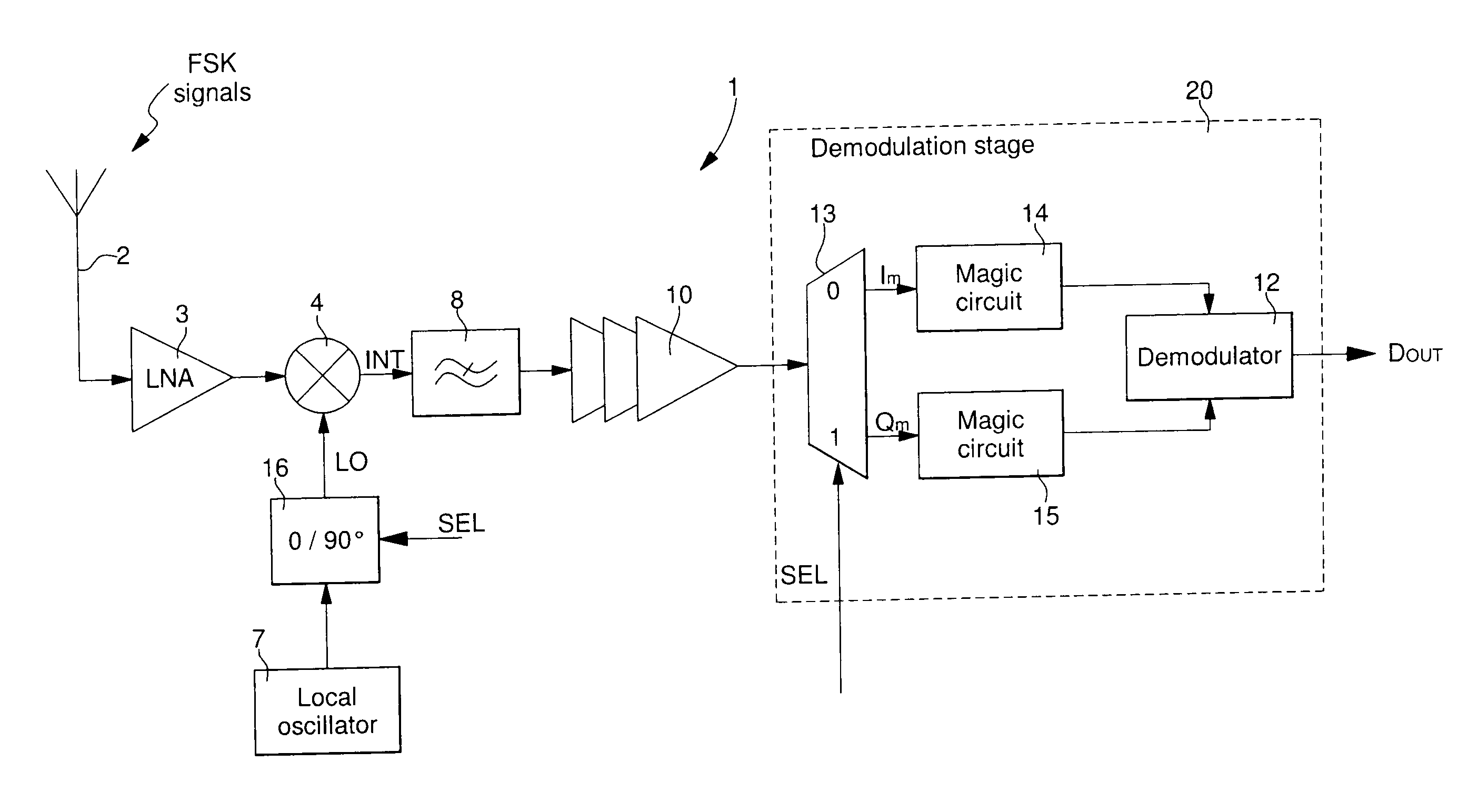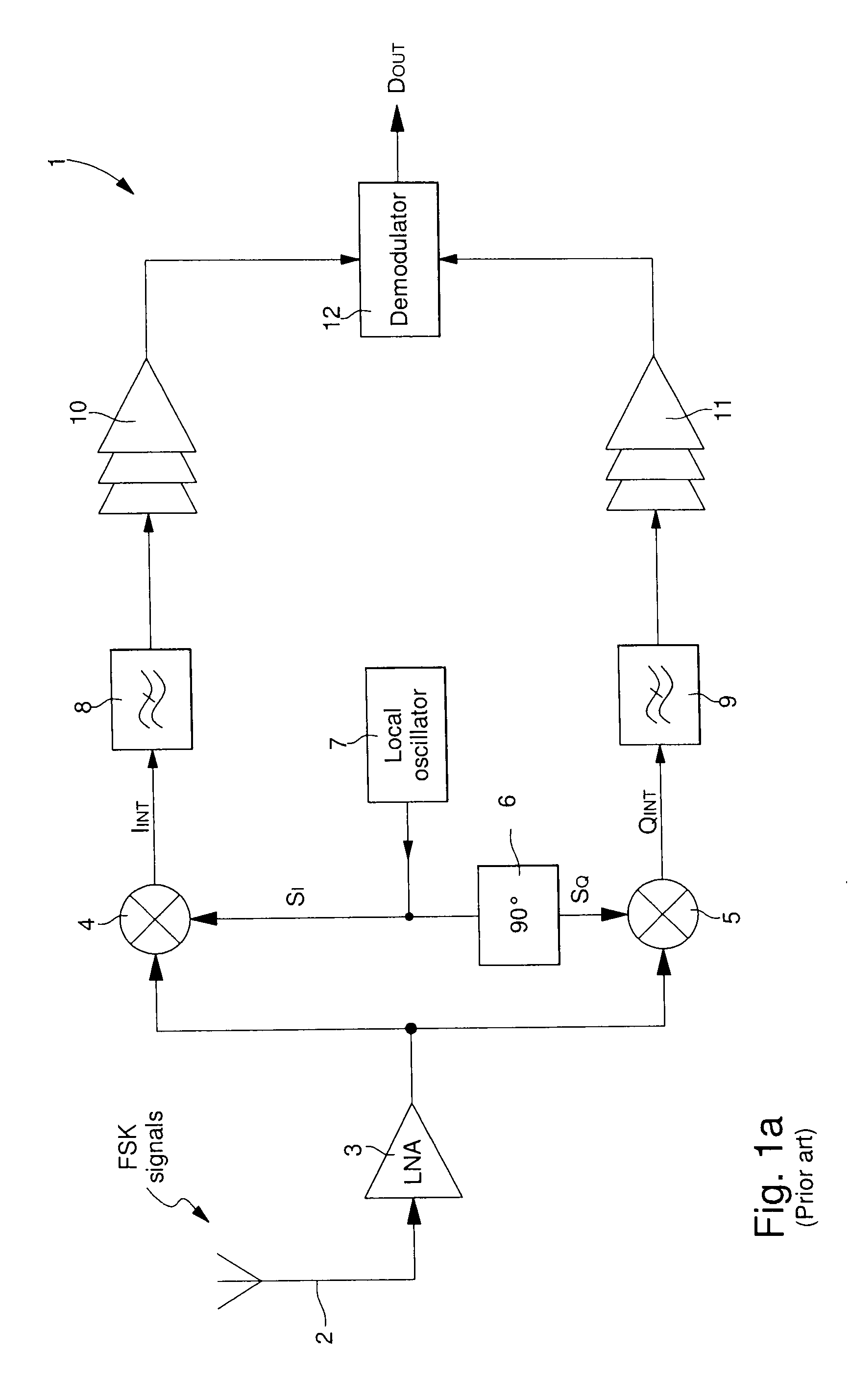Low rate, direct conversion fsk radio-frequency signal receiver
a radio frequency signal and receiver technology, applied in the field of low rate and direct conversion radio frequency signal receivers, can solve the problems of high frequency, high electric power consumption of the receiver, and the need for a low-pass filter with a very broad bandwidth, and achieve low power consumption, high sensitivity, and low rate mode
- Summary
- Abstract
- Description
- Claims
- Application Information
AI Technical Summary
Benefits of technology
Problems solved by technology
Method used
Image
Examples
first embodiment
[0034]the FSK radio frequency signal receiver 1 is shown in FIG. 2a. The receiver of FIG. 2a includes first of all, an FSK radio frequency signal receiver antenna 2 and an LNA 3 for conventional amplification and filtering of the FSK signals. The receiver also includes a local oscillator 7 for providing oscillating signals LO to a phase shift circuit 16. The oscillating signals LO are generated with an equivalent frequency to the carrier frequency f0 of the incoming FSK signals. Phase shift circuit 16 is controlled by a phase selection signal SEL so as to phase shift from 0° to 90° or vice versa the oscillating signals LO supplied by local oscillator 7 in each semi-period of a switching cycle 1 / fs. This enables a single mixer 4 to be supplied alternately with in-phase oscillating signals and quadrature oscillating signals, which are phase shifted 90° relative to the in-phase oscillating signals.
[0035]The in-phase oscillating signals are, for example, supplied when the signal SEL is ...
second embodiment
[0054]FIG. 5 describes a second simplified embodiment of a local oscillator, which integrates the phase shift circuit for the FSK radio frequency signal receiver of FIG. 2a. This local oscillator is preferably a frequency synthesiser with two delay units 46 and 47 that can be switched by phase selection signal SEL. Since several components of the frequency synthesiser of this second embodiment are identical to those described with reference to FIG. 4a, for the sake of simplicity, the description thereof will not be repeated.
[0055]The difference between this second embodiment of the frequency synthesiser and the first embodiment described above with reference to FIG. 4a is thus that two switchable delay units 46 and 47 are used instead of the sigma-delta modulator. The oscillating signals LO generated by VCO 34 are divided in a standard divider-by-N or a multi-mode divider 45 as desired, before the divided signals are directed to the input of the first delay unit 46 and the second de...
third embodiment
[0057]FIG. 6 describes a third simplified embodiment of a local oscillator, which integrates the phase shift circuit for the FSK radio frequency signal receiver of FIG. 2a. This local oscillator is preferably a frequency synthesiser with two delay units 56 and 57 that can be switched by phase selection signal SEL. Since several components of the frequency synthesiser of this third embodiment are identical to those described with reference to FIGS. 4a and 5, for the sake of simplicity, the description thereof will not be repeated.
[0058]This third embodiment of the frequency synthesiser is very similar to the second embodiment shown in FIG. 5. In this third embodiment, the two delay units 56, 57 are arranged this time between the reference oscillator 30 and the phase and frequency detector 31. The oscillating signals LO generated by VCO 34 are only divided by the programmable or multi-mode divider 55. This programmable divider 55 supplies divided signals to the phase and frequency det...
PUM
 Login to View More
Login to View More Abstract
Description
Claims
Application Information
 Login to View More
Login to View More - R&D
- Intellectual Property
- Life Sciences
- Materials
- Tech Scout
- Unparalleled Data Quality
- Higher Quality Content
- 60% Fewer Hallucinations
Browse by: Latest US Patents, China's latest patents, Technical Efficacy Thesaurus, Application Domain, Technology Topic, Popular Technical Reports.
© 2025 PatSnap. All rights reserved.Legal|Privacy policy|Modern Slavery Act Transparency Statement|Sitemap|About US| Contact US: help@patsnap.com



